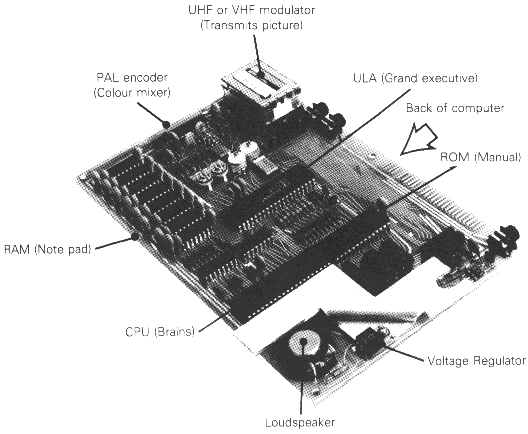ZX SPECTRUM Introduction
ZX SPECTRUM Introduction |
9. What's Inside the Case? The picture here shows what the inside of the ZX Spectrum looks like. |
 |
Figure 10 As you can see everything is named by a three letter abbreviation. The black rectangular pieces of plastic with lots of metal legs are the integrated circuits that actually do all the work. Inside each one is a ¼" X ¼" square of silicon joined by wires to the metal legs. On that silicon chip are thousands of transistors that make up the electronic circuits that are the computer. The brains behind the operation is the processor chip, often called the CPU (Central Processor Unit). This particular one is called a Z8OA, which is a faster version of the popular Z8O. The processor controls the computer, does the arithmetic, looks at what keys have been pressed decides what to do as a result, and in general decides what the computer should do. However, for all its cleverness, it could not do all this on its own. It knows nothing about BASIC or decimal point arithmetic, for example, and it has to get all its instructions from another chip, the ROM (Read Only Memory). The ROM contains a long list of instructions that make a computer program, telling the processor what to do under all foreseeable circumstances This program is written not in BASIC, but in what is called Z8O machine code and takes the form of a long sequence of numbers. There are altogether 16384 (16*1024) of these which is why ZX Spectrum BASIC is sometimes called a 16K BASIC - 1K is 1024 Although there are similar chips in other computers, this particular sequence of instructions is unique to the ZX Spectrum and was written specially for it. The eight chips next to it are for the memory. This is RAM (Random Access Memory and there are two other chips that work closely with them. RAM is where the processor stores information that it wants to keep, any BASIC programs the variables, the picture for the television screen and various other items that keep track of the state of the computer. The big chip is the ULA (Uncommitted Logic Array) chip. It really acts as the ‘communications centre', making sure that everything the processor requires actually gets done; it also reads the memory to see what the television picture consists of and sends the appropriate signals to the TV interface. The PAL encoder is a whole group of components that converts the logic chip’s television output into a form suitable for colour televisions The regulator converts the slightly erratic voltage of the power supply to an absolutely constant five volts. This concludes the Introductory Booklet. If you feel that you have understood it well we suggest that you now try reading the BASIC programming manual. |
|
|
|||||||||||||||